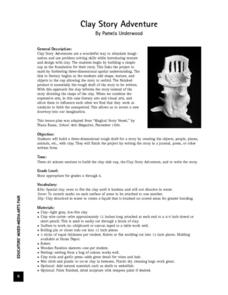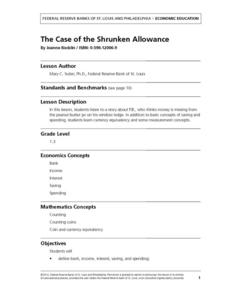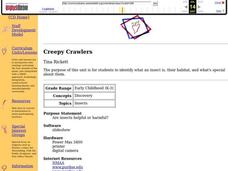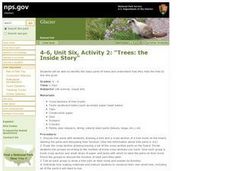Curated OER
The Power of Persuasion
Learners explore the power of persuasion. In a classroom setting, students discuss incentives, testimonials and deceptive pricing schemes that are used to influence others. After observing professionally made infomercials, learners...
Curated OER
Global Warming Statistics
Students research real-time and historic temperature data of U.S. and world locations, and analyze the data using mean, median, and mode averages. They graph the data and draw conclusions by analyzing the data. A spreadsheet is used to...
Curated OER
American Civil Rights Movement, Photo Essay
Learners view photographs from the Civil Rights Movement and write an essay from the point of view of someone in the photograph. They artistically represent various aspects of the Movement.
Curated OER
Clay Story Adventure
Young scholars build three-dimensional rough draft for a story by creating objects, people, places, animals, etc., with clay, and write story in a journal, poem, or other written form.
Curated OER
Gratitude Journals
Students brainstorm ideas of thankfulness or being grateful for things and use these ideas to create a personal gratitude journal. They build a book using copy paper, twigs and rubber bands then explore different techniques to create a...
Curated OER
Why Koala Has A Stumpy Tail
Students examine Australian folktales. In this folktales lesson, students read the Australian folktale, Why Koala Has a Stumpy Tale. Students list characteristics of the characters from the book. Students act out these characteristics...
Curated OER
When Clay speaks
Students listen as the teacher reads "When Clay Sings," by Byrd Taylor. They discuss clay, and view a variety of clay items. Students watch a video clip "Interests in One of a Kind Pots." They watch a demonstration on working with clay....
Curated OER
Agriculture Counts
Students discuss the kinds of things they count and how to use tally marks. In this social science lesson, students count animal crackers by using tally marks for each kind of animal. The tally marks are changed into numbers and one...
Curated OER
Geometric Houses
Students identify the parts and functions of a house by creating a house made of geometric shapes. They listen to the book "Houses and Homes," and use cues from the story to help them build their homes.
Curated OER
Petroglyphs and Pictographs
Fourth graders make necklaces out of petroglyphs that they stamp into clay. In this petroglyphs lesson plan, 4th graders draw designs and explain where they come from as well.
Curated OER
Spatial Relationships: an Over/Under Dance
Students explore the relationships of space through movement. Two perform movement improvisation based on over/under. The activity improves hand-eye coordination, cooperation, and communication skills. The timing of the dance also...
Curated OER
Our Community- In Sculpture Form
Students use the works of William H. Johnson as the basis for a project. The objective is to use his works as a demonstration of communication to the community. The sculpture is supposed to be made out of clay.
Federal Reserve Bank
Bunny Money
Teach your class about saving, spending, and goal setting with a story about a couple of bunnies who went shopping and related activities. Learners keep track of the bunnies' spending, practice identifying long- and short-term savings...
Federal Reserve Bank
Less Than Zero
Perry the penguin wants to buy a new scooter, but he doesn't have any funds! Walk your kids through the short book Less Than Zero, and have them track his borrowing, spending, and saving on a line graph while you read. Pupils will learn...
Federal Reserve Bank
The Case of the Shrunken Allowance
An allowance is an important thing! Make sure your kids know how to save and spend their own money. Using the book The Case of the Shrunken Allowance as a starting point, this plan covers income, spending and saving, counting, and more.
Curated OER
Adire Eleko Cloth Glue Patterns
First graders are introduced to the art form of African Adire Eleko cloth - painted patterned textiles. They use paper, glue and paint to imitate the technique and create similar patterns on paper.
Curated OER
Doorways/Printmaking
Students are introduced to the techniques used in printmaking along with the relief method and tessellation relationships to art. In groups, they examine a variety of architecture used throughout the Islamic culture. To end the lesson,...
Curated OER
Creepy Crawlers
Students identify the characteristics of an insect and their habitat. They read books about insects, research different types of insects, and create their own insect art. The project also includes the creation of an insect song and...
Curated OER
The Places We Love
Students examine how they and others express themselves. Using various writings and art, they discover the places they like to go in the world and share them with their classmates. They paint their favorite place and share their...
Curated OER
New Year Celebrations Around the Globe
Students view art images of Norman Rockwell's family traditions and celebrations. They search the internet for information, and complete reflective and creative writing and sketch assignments. Students recognize and name emotions shown...
Curated OER
The Starry Night Time and Day Time
Second graders complete a unit of lessons on the solar system. They complete various art projects inspired by Van Gogh's 'Starry Night,' create a moon phases book, create a moon phase wind chime, develop a timeline of space exploration,...
Curated OER
Making Estimations in Measurement
Students explore estimating and measurement with the story of Jack and the Beanstalk. They read and discuss the story, estimate and measure their own height, circumference, and length of their foot, and draw and paint a giant using...
Curated OER
Moving Rhythms
Students explore the elements of tempo, beat and rhythm. They create rhythm patterns and an original dance. In groups, students perform their phrases for their peers. As a class, they explore choreographic principles, processes and...
Curated OER
Trees: The Inside Story
Students explore trees. In this math lesson, students identify the basic parts of trees. Students create a model of a tree and label the parts.























